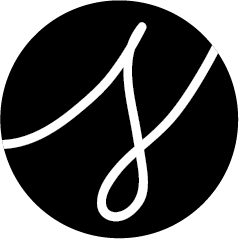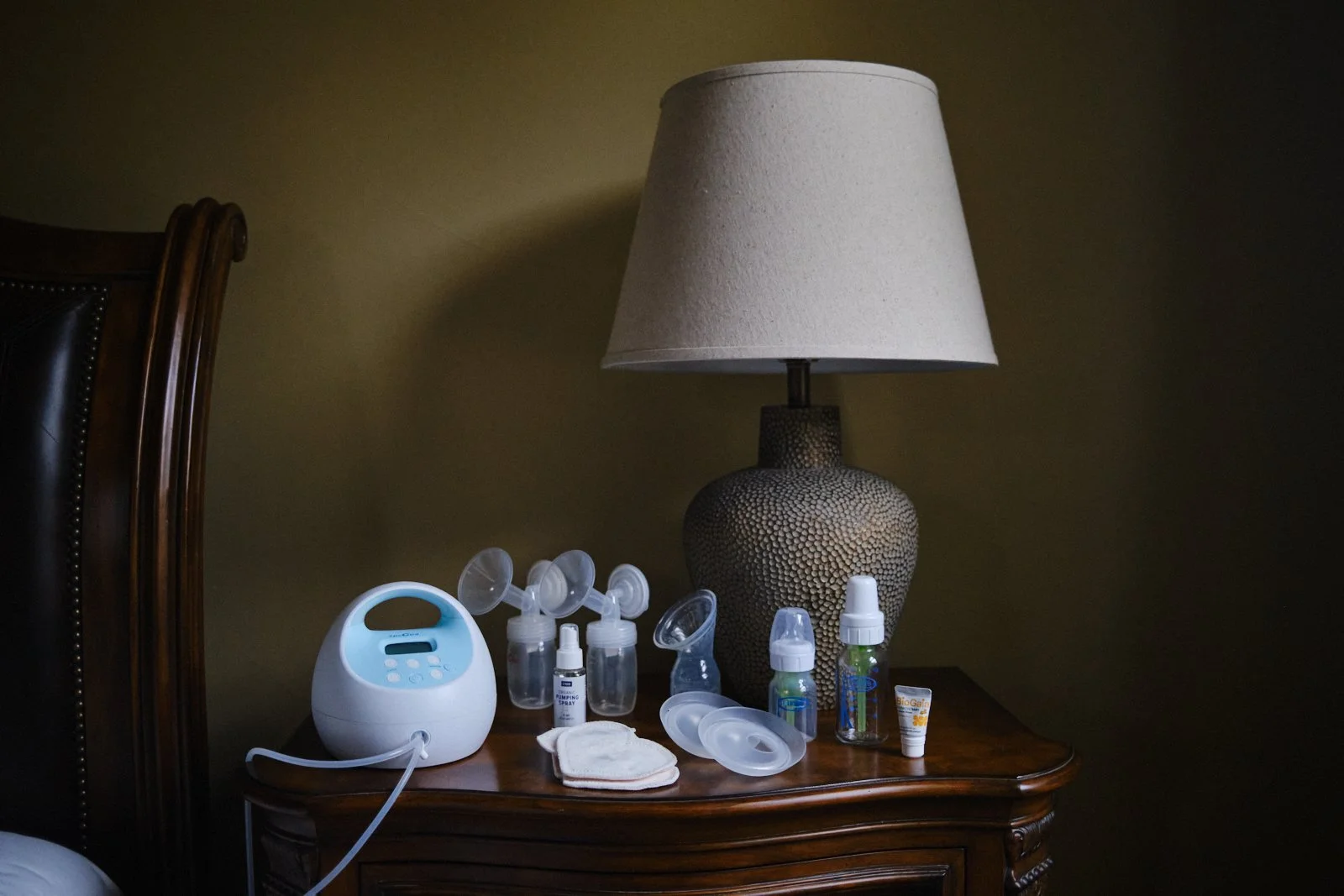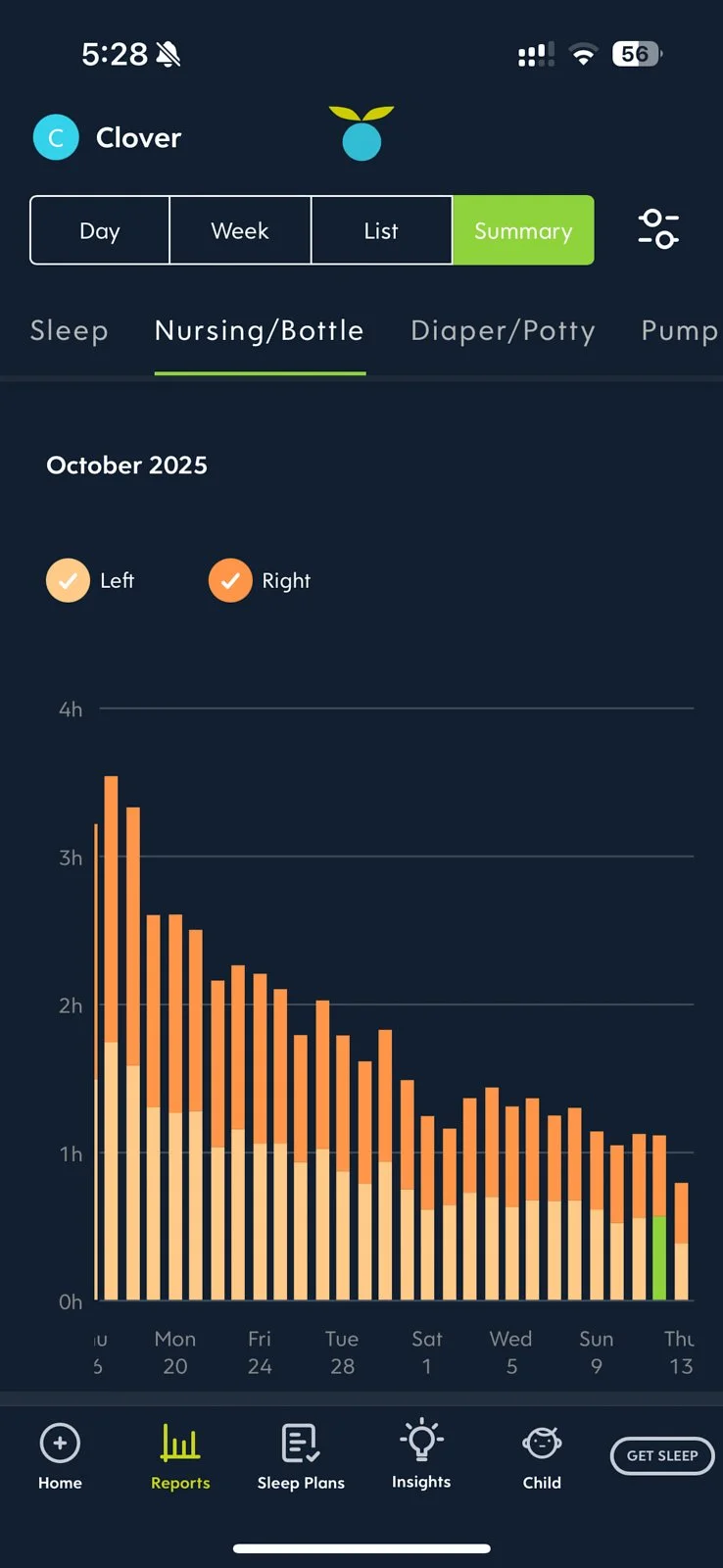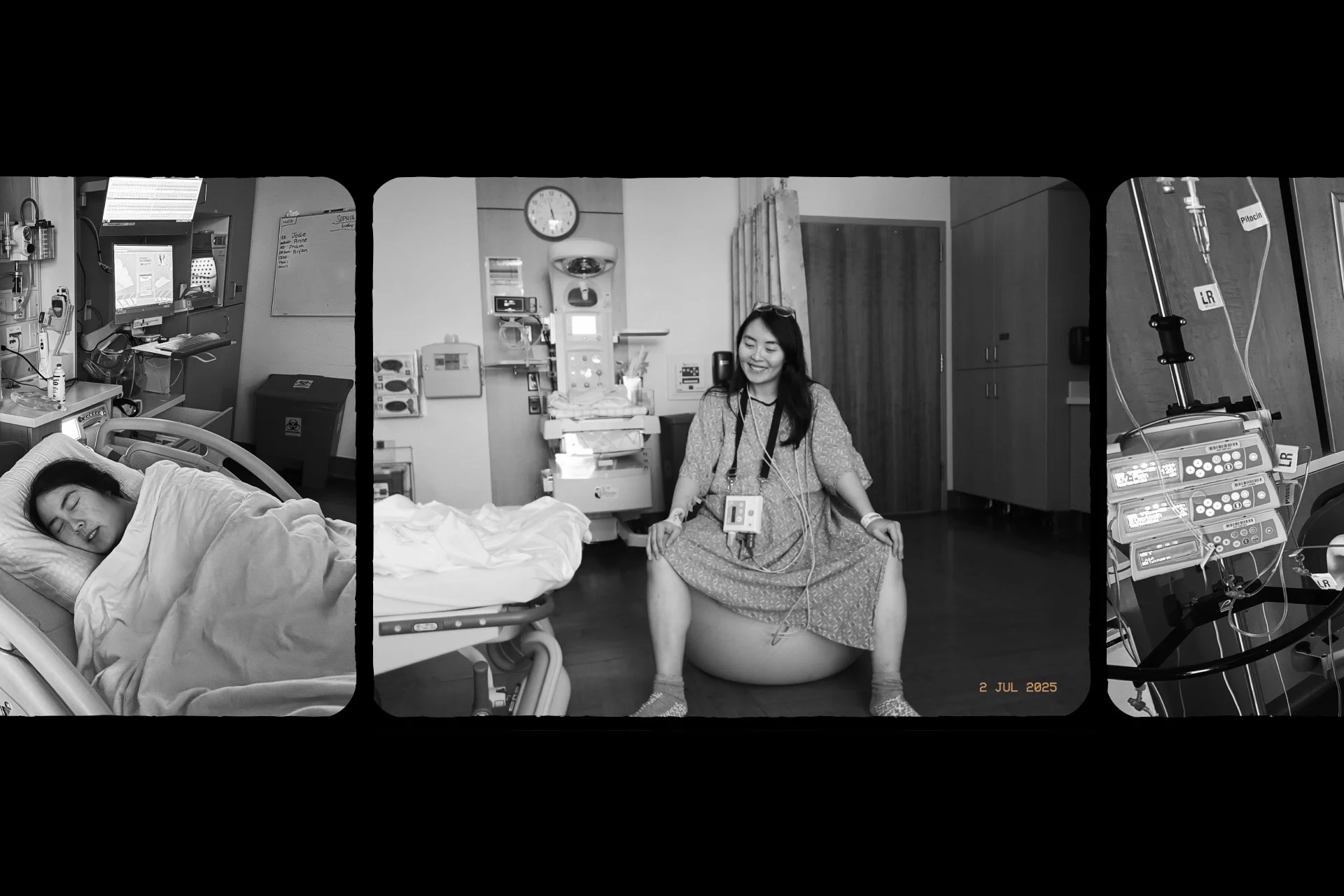Nursing Journey
Now that I’m 4 months into nursing my baby and keeping her alive, I thought I’d jot down some things that might help a mama friend in the future. My naive self always knew breastfeeding was natural so I thought it must be intuitive and easy. Every generation of women has done it before — how hard could it be? Bold of me to assume.
A photographic still life of my new life as a cow.
My birthing hospital pushed for breastfeeding, which I didn’t mind. There are many benefits to the baby (fewer allergic rashes and gastrointestinal disorders) and benefits to mom (lower risk of breast cancer). The nurses were trained to help families initiate breastfeeding, and from birth, they taught me how to get baby to latch. But really quickly, things got excruciating. Feeling like I could handle any pain after going through childbirth, I let the toothless but ruthless newborn destroy my nipples in every attempt to feed her whatever colostrum I could squeeze out. My nipples bled immediately, and before they could recover, it was time to nurse again. The next few days I clenched my teeth as I slammed her onto my chest every 2-3 hours. I was high off adrenaline, and although my breasts and nipples were tender, I kept going. With her jaundice and weight loss on the verge of because a real problem, I was anxious about whether she was getting enough food. I squeezed my boobs as hard as I could by hand while she was latched on, praying something nutritious would transfer into her mouth. By day 4 I felt the strange sensation of liquid oozing out — my milk finally came!
Even though I was happy to finally feed my baby actual liquid breastmilk, my breasts had not healed. In fact, they did not recover for another few weeks. I dreaded every nursing session because I knew I’d have to put myself through more pain. Baby girl loved to hysterically cry for milk, so the panic of getting her latched added another layer of difficulty. She would open and close her mouth in mid-air and I’d have to aim my nipple into her mouth and get the timing just right to maximize her latch. Other times she’d get frustrated and shake her head back and forth rooting while her goalpost fists and razorblade nails would get in the way and guard my boob from getting near her mouth. We’d fight over this constantly, and I’d get so frustrated Simon would have to intervene and peel her hands back (which angered her more) just to get her onto me. It was a battle we fought 8-10 times a day, and lasted for almost a month.
In the early weeks, she also choked on my letdown. She’d unlatch herself right when my milk was coming out like a firehose, causing it to squirt all over her face and whatever else was around us. Ali Wong describes it best.
“Giving birth ain’t nothing compared to breastfeeding.”
Outside of actually nursing, my breasts were learning to regulate milk supply by demand. This meant they’d produce milk at varying speeds, frequently causing my breasts to get super full (i.e. engorged), then leak uncontrollably. I leaked constantly. I’d leak when I heard baby cry, when coming out of a warm shower, and when baby napped too long. Leaking combined with nipple tenderness (I did not want a single thing touching them, not even fabric) made everyday living hard. I’d walk around the house topless but also panicked when I’d feel the zing sensation and see milk dripping.
Thankfully this resolved by the third month, but boy was the learning curve high. Since I was new to everything, I had to learn on the spot, text my mama friends, read countless articles on La Leche League and Kelly Mom, research products, and book appointments with a lactation consultant. Here’s what I’ve learned.
breastfeeding
Everyday, I nursed on-demand and alternated between three needs: 1. healing, 2. protecting from leakage, and 3. saving milk. Depending on time of day and time elapsed between feeds, I had different milk supply and different needs. Even though I took breastfeeding courses during pregnancy, they were useless when the time came to put it into action. It took me almost a month of experimenting by doing (that’s 300+ nursing sessions!) to figure out what worked for me.
Basic SUPPLIES
A small table next to you to hold all the supplies: tissues, phone, collection shells, Haakaa, water bottle and snacks
Lactation consultant (i.e. IBCLC) who acts as a teacher/doctor to help you learn to nurse in the early days. I thought my LC was just as important as the pediatrician in the first few weeks
An app to track timing and duration of feeds (I use Huckleberry)
Optional: Nursing glider chair, to make breastfeeding a more enjoyable experience. Because taking care of your own body is just as important as baby’s!
Optional: Pillows. Since you have your hands full holding baby, have your partner stick pillows into the crevices under your arms/hands to relieve your muscle tension and prevent carpal tunnel. We did this for the first month until I got comfortable leaning back in bed with a cradle hold. I also used My Brest Friend for a bit but it was annoying to have to turn it left and right when I used the football hold. And it didn’t allow for placing baby in a more vertical feeding position that aids in minimizing reflux.
Optional: Storage caddy to hold your supplies (especially a Haakaa when it’s full of milk). I found this one at Target and still use it everyday.
1. Healing
Motherlove Nipple Cream, to prevent nipples from chafing against fabric. It’s much softer to apply than lanolin cream. Used for first two months until I lost feeling in my nipples. (Thank god.)
Silverette Nursing Cups, worn between nursing sessions almost like armor for your nipples. They’re made from silver, which has antimicrobial and anti-inflammatory properties. However, my lactation specialist didn’t recommend them, saying it’s not good to keep your nipples soaking in wetness. But I used for first few weeks regardless because not having them on was too painful.
Ameda BreastShells, worn to recover from pain. I got these from the hospital but tried to avoid wearing them too much since they can inflame areolas if worn too long. Used for first few weeks.
2. Protect from leakage
Nursing bras. Obviously you could go shirtless but a bra is useful for holding in collection cups, nursing pads, and protecting your nipples from a squirmy newborn’s sudden jerky movements. Size up so the fabric doesn’t pull on your nipple, but always best to try on in-person to test comfort. (I found mine at Target.) There’s also a hack to use these as pumping bras so you don’t need to buy separate ones. I wear them 24/7 now.
Nursing pads, whether disposable or reusable. My delicate postpartum skin was slightly allergic to the disposable ones so I found reusable Bamboobies, which I still wear every night.
Burp cloths, to cover your lap during feeds while baby is messily feeding, and then to act as a bib when baby spits out milk. Some people also use them as nursing pads to catch leaks.
3. Saving milk
Breastmilk collection cups (my favorites are the Elvie Catch), worn on the opposite breast to collect leaked milk while baby is nursing. I have about 8 of these and wear them every session to collect milk, which I then pour into a bottle to supplement baby later.
Haakaa Silicone Breast Pump, to collect leaking milk while baby is nursing on the opposite breast. I started with this method, but quickly realized how easily it could be kicked off by the baby’s tiny engine legs (which will make you cry over spilled milk). And because it has a bit of suction, my LC didn’t recommend using them until the second breast to avoid taking milk away from the baby.
Glass bottle to consolidate daily fridge collection.
Breastmilk storage bags to transfer any extra milk to the freezer.
To clean, we use a dedicated bowl to collect milk-soiled nursing objects throughout the day, and a dedicated sponge brush to wash them nightly with hot water and soap. The best investment here is a patient husband who does the washing.
Building milk supply
In the early days, it’s common to worry about whether your milk supply is enough for your baby’s needs. My LC recommended a supplement (Legendairy Milk Liquid Gold Lactation Support) and eating foods that support milk production, like papaya and oatmeal. She also recommended a probiotic for me (SOLARAY Mycrobiome Probiotic Urgent Care) and for baby (BioGaia Protectis Baby Probiotic Drops) to help alleviate colic gas.
However, the most effective method of increasing milk supply is to empty the breasts frequently, either by nursing or pumping. Since it was easier to add pumping sessions than alter with baby’s nap-eat-play schedule, it was time to introduce the machine.
Pumping
Supplies
A breast pump. Most insurance plans cover a new pump with each pregnancy (thanks Obama!) and I chose the popular Spectra S1, an effective workhorse of a pump that fit my needs. Since I planned to exclusively breastfeed for the first 6 months, I didn’t need on-the-go wearable pumps.
Bottles to feed milk. We have Dr. Brown Anti-Colic bottles, and used the paced feeding method with Size 1 nipples because my impatient baby inhales milk like she’s never eaten in her life.
Optional: Pumping spray for comfort. Essentially a lubricant that reduces friction where your skin touches the pump flange, I’ve found that it helped with the soreness. I have this one.
Optional: A better fitting flange. The Spectra comes with 24mm and 28mm flanges, which were huge for me. Ill-fitting flanges only end up promoting more nipple soreness and yields less milk output, so I roughly measured my size and bought 19mm flanges from Maymom that fit much better.
Optional: Cooler bag and ice pack, for traveling with bottles. If not going to a restaurant, we also bring a deli container and hot water in a thermos to warm up bottles.
Around four weeks, I wanted to introduce my baby to bottle before her tastes solidified. Babies can reject bottle in favor of breast, so I was determined to build her flexibility in accepting both breast and bottle so I wouldn’t be the only person able to feed her for an entire year. To do this, I had to squeeze a pump schedule into my nursing routine to ensure she got at least a bottle a day. I worked with the lactation consultant to figure out the schedule:
Pump #1: Because we naturally have more milk in the morning, add an extra pump session in between first and second feeds in the morning, and refrigerate milk to have extra milk to supplement on hand or add to freezer stash. This pump session helped build and maintain my milk supply.
Pump #2: Replace a feed with a pump session and bottle. Basically omit a direct breastfeed in favor of pumping, then transfer that milk to a bottle to feed her immediately. I had Simon feed her this bottle so she could get comfortable being fed by anyone.
Luckily my baby is food-motivated, so she had no problem switching between breast and bottle. This helped us plan for outings and decide how to feed her when we’re visiting the pediatrician, going to a restaurant, or hanging out at grandma’s house. If we’re scheduled to be somewhere at a specific time, I’ll pump ahead of time or in the car. This way we can easily and quickly bottle-feed her when she cries for milk and I don’t have to find a private room or awkwardly hide her under my shirt while in public settings.
With pumping and bottle-feeding comes a lot more dishes. We wash everything at the end of the day collectively with the rest of the milk-soiled nursing objects. Sterilizers and bottle washer/dryers exist out there but we didn’t see a need to invest in them. Don’t forget to plan for all of this when you’re traveling as well.
This shit is hard
Around 10 weeks, I stopped leaking as much during the day while my supply regulated. Around that time, baby girl also started sleeping through the night (woohoo!) so I had to let my supply adjust. Suddenly going 10 hours without emptying the breasts meant leaking all over the bed. I’d soak through nursing pads and bra and shirt. When I finally found a method to catch leaks (wear collection shells to sleep), I developed acute hives. For 6 weeks, I’d wake up in the mornings covered in heinous itchy red spots. My doctors couldn’t explain why I got them, but I suspect it was the excess prolactin at night. The postpartum body is incredibly mysterious (my immune system was rebooting itself after all) and the only thing I could do to relieve the severity was pump. So even though baby was sleeping through the night, I had to set an alarm to wake myself up at 1am and pump. Sigh.
But it got better!
This shit is also magical
Breastfeeding has one of the highest learning curves out of anything parenting-related. It’s amazing what our bodies can do, and even more amazing the dedication that moms put into feeding their babies. Even though they’re my breasts, my baby has a special connection to then that I’m not a part of. When she gets hungry, my breasts always knew. I’d get that zinging feeling when my milk wanted to be expressed, and somehow, not even a minute later, I’d hear baby wake up and cry for food. I joke to everyone that when she’s latched on, she’s drinking her meal and placing an order for tomorrow. And day after day, my body delivers.
We are lucky to have a baby who doesn’t have a tongue tie, latched immediately (an hour after birth), is a good eater, takes bottle from anyone, and finishes every bottle… It’s worth the gassiness, the spit-up, the impatience and demanding cry for food because we trust she knows to keep herself fed and growing well. This gives me the flexibility to go back to work and spend time away from her when needed. I’m also incredibly grateful for a generous maternity leave period and ample milk supply that allows me to feed my baby breastmilk. Not all mothers can, and luckily formula is available as an alternative. (In the first two weeks, we used formula to supplement every feed to prevent more jaundice and weight loss.) At the end of the day, fed is best!
The biggest thank you to my mama friends for all the advice during the early days! I’ve had breasts my whole life but learning to use them to provide for a baby is a whole new skill I had to learn on the spot. I felt stupid asking questions about how my own breasts work during a very frantic postpartum time, and I wouldn’t be here without the secret society of moms coming together to help me out. So, to my friend currently reading this, hit me up and ask all the dumb questions. I’m here for you!
Here’s to a few more months of nursing and tackling whatever mom life throws at me next.
























My naive self always knew breastfeeding was natural so thought it must be intuitive and easy. Bold of me to assume. “Giving birth ain’t nothing compared to breastfeeding.”